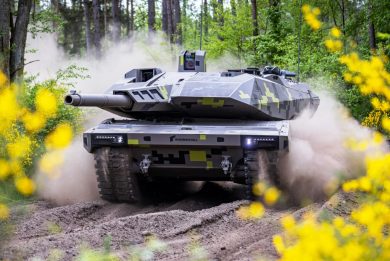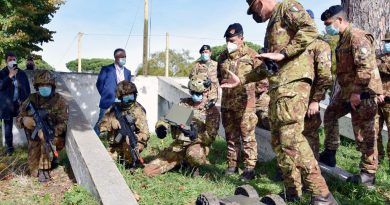
Rheinmetall ROSY goes vertical providing last ditch defence against incoming drones
The increasing threat posed by drones is bringing all major defence industry players to find solution against those systems, some of them being active both in the attack drones and in the defence against them. One of these is Rheinmetall, which on one side is developing small loitering munitions that will provide indirect fire surgical capacity to its armoured vehicles, and on the other is looking at solutions to neutralise the same threat posed by the enemy
The ROSY, the acronym for Rapid Obscuring SYstem, was visible at the Rheinmetall Mobility Days 2025 event, which took place in late June at the Rheinmetall MAN Military Vehicles plant in Vienna and at the Offroad Zentrum Stotzing, some 30 km south of the Austrian capital town.

As in the defensive “onion concept” not be seen remains among the very first layers, the Düsseldorf-based group leveraged the experience acquired in smoke obscurants to provide a first response to the problem. One of the Rheinmetall key products in the vehicle protection field is the ROSY, which is capable to create dynamic smoke screens, hiding the vehicle while it is on the move.
Different types of launchers are available; three sizes of modular launchers, known as 1M, 2M and 3M, where the number indicates the number of modules, each capable to host five 40 mm grenades, or the ROSY_Mod, for modular, a single-tube system which gives more freedom of integration having a lesser footprint as it hosts a single grenade. The multiple launchers are linked to a manual control unit (MCU) that can manage up to four launchers, each with three magazines, and features an integrated emergency power supply, as well as CAN-bus/Ethernet interfaces. These may be used to link the system to a sensor, the latter requiring the activation of the specific grenade launcher depending on the threat direction and on the vehicle movement. However, EDR On-Line understood that for the time being most customers selected to maintain the ROSY in the manual mode, the MCU allowing to select the launcher thanks to a set of switches, LEDs also showing the loading status of each launcher. Firing mode, single or burst, as well as the type of ammunition, should some of the launchers being loaded with riot control grenades. Launchers can be fixed to the vehicle hull or can be installed via a quick-release interface, which allows for example to fit all the fleet for using the ROSY, while acquiring a lesser number of launchers, which would be installed only on platforms meant for operational use.
The ROSY_Mod is composed of a single launcher module, which hosts the ammunition, and of the firing electronics (FE) Box, the latter being capable to manage up to 10 launcher modules. FE Boxes are then connected to the MCU. This solution allows to install the launchers with great flexibility, according to the platform architecture and to the customers’ needs, for example integrating the launchers into the hull, with only the ammunition protruding from the armour.

With the increasing threat coming from the sky, Rheinmetall verified the feasibility of using the ROSY ammunition to provide cover against incoming drones, hiding the target to the sensor, would be it human or not. The ROSY round has a calibre of 40 mm and is 280 mm long, with a mass of approximately 418 grams. The smoke round, the one used for screening purposes, contains around 140 grams or red phosphorus, and generates the screening effect with a delay time of 0.5 seconds, at 25 metres from the vehicle, screening in the visual spectrum reaching full effectiveness after 1.5 seconds and lasting over 20 seconds. It is effective not only in the visual spectrum but also in the infrared one, as it can screen signatures in the 3-5μm and 8-12μm, hiding the vehicle also from the view of thermal imagers.
Installing ROSY_Mod launchers at high elevation angles would allow generating a could over the vehicle, hiding it to incoming drone/s therefore neutralising their ISR capability, at least for an interval of time, or impeding them to attack the vehicle. Once the contact broken, the vehicle can take evasive manoeuvres and react in the appropriate way.

From that application came the idea to develop a specific package dedicated to countering aerial threats, the ROSY Vertical Launch, ROSY_VL in short. The system puts together 10 ROSY launchers into a pyramid-like structure in which each launcher is installed in a near-vertical position. To provide a sufficient cover, in the form of a hemispherical cloud of smoke, the 10 40 mm grenades are fired in rapid sequence, reach an altitude of around 25 metres above the vehicle, hiding the platform from the incoming drone.
Detecting incoming drones is not always easy task, reaction time is pretty short, the system allows only one shot, and Rheinmetall proposes its ROSY_VL as a last ditch defence; it is to be seen if some customer will decide to link it to some form of low-cost warning system, to increase its effectiveness by activating it at the right moment, something that in our opinion could not be easy task for an operator, especially if working inside an armoured vehicle.

The ROSY_VL effect can be enhanced by installing ROSY_Mod modules in near-vertical position on the vehicle, while standard ROSY elements ensure 360° screening around the vehicle against surface threats. The ROSY_VL has an empty mass of 22 kg including the FE Box which is contained into the system, which becomes 27 kg when loaded with the 10 ammunition.
Rheinmetall Waffe Munition, is currently finalising the mounting and the housing of the ROSY_VL. Since ROSY_VL is based on proven ROSY component6s, the launchermodule and the FE Box, the system being considered to be at TRL 8. The ROSY originating from the RWM plant of Schneizlreuth, a location south-east of Munich, along the German-Austrian border. EDR On-Line understood that currently the munition used is the standard ROSY smoke 40 mm grenade.
Photos courtesy Rheinmetall and P. Valpolini


